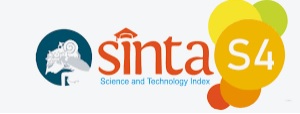Optimalisasi Algoritma Deep Learning Menggunakan Deteksi Tepi Pada Identifikasi Varietas Ikan Nila
Abstract
Tilapia is a fish species that is considered invasive throughout the world, but has high economic value in Indonesia because of its environmental resistance and popularity. There are 12 superior varieties of tilapia that want to be identified in this research. Because the shape of the fish's body, fins, head and other physical characteristics are similar to each other, errors often occur in the process of identifying the type of tilapia when done by humans. Therefore, this research will use computational methods to assist in identifying fish morphology by identifying the morphology or physical characteristics of 12 varieties of tilapia and overcoming errors that often occur in the identification process by applying the edge detection method. This technique will improve image quality and identification accuracy through the Deep Learning algorithm, by optimizing the feature extraction process in the Deep Learning algorithm through edge detection, proven to be 0.9 but the lowest accuracy value was obtained in sobel edge detection combined with LSTM, namely 0.12. It is hoped that this research will increase accuracy and efficiency in identifying the morphology of tilapia fish. This will help experts carry out morphological analysis of tilapia fish more quickly and effectively
Keywords: Oreochromis niloticus; Deep learning; Identification; Image processing
Â
Abstrak
Ikan nila adalah spesies ikan yang dianggap invasif di seluruh dunia, tetapi memiliki nilai ekonomis yang tinggi di Indonesia karena ketahanannya terhadap lingkungan dan popularitasnya. Ada 12 varietas unggul ikan nila yang ingin diidentifikasi dalam penelitian ini, karena bentuk tubuh ikan, sirip, kepala dan ciri fisik lainnya mirip satu sama lain maka sering terjadi kesalahan dalam proses identifikasi jenis ikan nila jika dilakukan oleh manusia. Oleh karena itu penelitian ini akan menggunakan metode komputasi untuk membantu dalam identifikasi morfologi ikan dengan untuk melakukan identifikasi morfologi atau ciri fisik dari 12 varietas ikan nila serta mengatasi kesalahan yang sering terjadi dalam proses identifikasi dengan menerapkan metode deteksi tepi. Teknik ini akan meningkatkan kualitas citra dan akurasi identifikasi melalui algoritma Deep Learning, dengan mengoptimalkan proses ekstraksi ciri pada algoritma Deep Learning melalui deteksi tepi, terbukti 0,9 namun nilai akurasi terendah didapatkan pada deteksi tepi sobel yang digabungkan dengan LSTM yaitu sebesar 0,12. Penelitian ini diharapkan akan meningkatkan akurasi dan efisiensi dalam identifikasi morfologi ikan nila. Ini akan membantu para ahli dalam melakukan analisis morfologi ikan nila secara lebih cepat dan efektif.
Â
Keywords
References
L. S. Yamasaki et al., “Identification of Nile tilapia (Oreochromis niloticus) and its hybrids in natural environments in Hawaii,†Aquaculture, vol. 550, pp. 737–805, Mar. 2022, doi: 10.1016/j.aquaculture.2021.737805.
P. P. Debnath, M. D. Jansen, J. Delamare-Deboutteville, C. V. Mohan, H. T. Dong, and C. Rodkhum, “Is tilapia mortality a latent concern for the aquaculture sector of Bangladesh? An epidemiology and health economic impact study,†Aquaculture, vol. 560, no. 1, pp. 73–86, Nov. 2022, doi: 10.1016/j.aquaculture.2022.738607.
Kementrian Kelautan dan Perikanan, “Varietas Ikan Nila Indoensia,†Kementrian Kelautan dan Perikanan. Accessed: Oct. 30, 2023. [Online]. Available: http://sisinbe.kkp.go.id/
H. Santoso, S. Laili, and J. Biologi, “Kajian Morfologi Ikan Nila (Oreochromis niloticus) dalam Habitat Air Tawar dan Air Payau,†Jurnal Ilmiah Biosaintropis (Bioscience-Tropic, vol. 3, no. 1, pp. 10–17, 2018, Accessed: Oct. 30, 2023. [Online]. Available: https://biosaintropis.unisma.ac.id/index.php/biosaintropis/article/view/146
O. Zenal Arifin and T. Kurniasih, “Karakterisasi Morfologi Keturunan Pertama Ikan Nila (Oreochromis Niloticus) Get Dan Gift Berdasarkan Metode Truss Morphometrics,†Jurnal Riset, vol. 2, no. 3, pp. 373–383, 2019.
E. Deni Nugroho, D. Anggorowati Rahayu, and D. Rupa, “Studi Morfologi Ikan Mudskippers (Gobiidae: Oxudercinae) Sebagai Upaya Karakterisasi Biodiversitas Lokal Pulau Tarakan,†Jurnal Harpodon Borneo, vol. 9, no. 1, pp. 46–57, 2016, doi: https://doi.org/10.35334/harpodon.v9i1.49.
A. Purnama, S. Bahri, G. Gunawan, T. Hidayatulloh, and S. Suhada, “Implementation of Deep Learning for Handwriting Imagery of Sundanese Script Using Convolutional Neural Network Algorithm (CNN),†ILKOM Jurnal Ilmiah, vol. 14, no. 1, pp. 10–16, Apr. 2022, doi: 10.33096/ilkom.v14i1.989.10-16.
N. Petrellis, “Measurement of Fish Morphological Features through Image Processing and Deep Learning Techniques,†Applied Sciences, vol. 11, no. 10, pp. 1–23, May 2021, doi: 10.3390/app11104416.
A. Saleh, M. Sheaves, and M. Rahimi Azghadi, “Computer vision and deep learning for fish classification in underwater habitats: A survey,†Fish and Fisheries, vol. 23, no. 4, pp. 977–999, Jul. 2022, doi: 10.1111/faf.12666.
M. Sun, X. Yang, and Y. Xie, “Deep Learning in Aquaculture: A Review,†J Comput (Taipei), vol. 31, no. 1, pp. 294–319, 2020, doi: 10.3966/199115992020023101028.
M. Jahanbakht, W. Xiang, N. J. Waltham, and M. R. Azghadi, “Distributed Deep Learning and Energy-Efficient Real-Time Image Processing at the Edge for Fish Segmentation in Underwater Videos,†IEEE Access, vol. 10, pp. 117796–117807, 2022, doi: 10.1109/ACCESS.2022.3202975.
H. C. Altunay and Z. Albayrak, “A hybrid CNN+LSTM-based intrusion detection system for industrial IoT networks,†Engineering Science and Technology, an International Journal, vol. 38, pp. 101–322, Feb. 2023, doi: 10.1016/j.jestch.2022.101322.
R. Rizal Adi Saputra, R. Reskal, and F. Mimi Wahyuni, “Segmentasi Pada Plat Kendaraan Dinas Dengan Metode Deteksi Tepi Canny, Prewitt, Sobel, & Roberts,†Jurnal Sains Komputer & Informatika (J-SAKTI, vol. 6, no. 1, pp. 328–339, 2022, doi: http://dx.doi.org/10.30645/j-sakti.v6i1.448.
Md. M. Islam, Md. Z. Islam, A. Asraf, M. S. Al-Rakhami, W. Ding, and A. H. Sodhro, “Diagnosis of COVID-19 from X-rays using combined CNN-RNN architecture with transfer learning,†BenchCouncil Transactions on Benchmarks, Standards and Evaluations, vol. 2, no. 4, pp. 2–11, Oct. 2022, doi: 10.1016/j.tbench.2023.100088.
H. Masuda, T. Jukei, and T. Hasegawa, “Fish Species Identification Using a CNN-based Multimodal Learning Method,†in Proceedings of the 2020 2nd International Conference on Image, Video and Signal Processing, in IVSP ’20. New York, NY, USA: ACM, Mar. 2020, pp. 15–19. doi: 10.1145/3388818.3389164.
How To Cite This :
Refbacks
- There are currently no refbacks.











